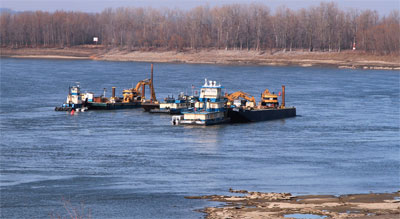After the near shutdown of the Mississippi River in December 2012, the U.S. Army Corps of Engineers is predicting that the river will stay open through the middle of February.
“We received a good amount of rain on the upper Mississippi around Jan. 12 and water levels are up three to five feet between St. Louis and Cairo, the area previously considered the bottleneck stretch,” said Bob Anderson, regional chief of public affairs for the Corps’ Mississippi Valley Division.
Rising water levels have prompted the U.S. Coast Guard to restore the usual draft limit of 12 feet in some areas.
The boost comes after six weeks of predictions that the Mississippi would close. During that time, stakeholders and members of Congress made repeated appeals to the Corps and the Obama administration, asking for the release of water from Missouri River reservoirs.
Low-water conditions, which have impacted commerce on the Mississippi since July 2012, worsened on Nov. 22, when the Corps began paring the outflow from a dam on the upper Missouri River in South Dakota, an event scheduled each year.
The following week, American Waterways Operators, Waterways Council Inc., and 16 other national organizations sent a letter to President Obama requesting that he direct the Army Corps to release water from Missouri River reservoirs so as to sustain a nine-foot channel on the Mississippi River. The letter also requested the removal of exposed rock pinnacles near Grand Tower and Thebes, Ill.
On Dec. 7, Army Assistant Secretary Jo-Ellen Darcy turned back these requests in a letter, stating that the Corps is legislatively bound to manage the Missouri River in line with those interests that depend on the Missouri, with what happens on the Mississippi being incidental. Darcy also said that the release of reservoir water could deplete drinking water sources and negatively affect recreation, animal habitat and hydropower on the upper Missouri River, which has also been impacted by the drought in the Midwest.
In mid-December, the Corps took action by releasing water from Carlyle Lake in Illinois and by beginning to remove rock pinnacles at Thebes. The rock removal project called for closing the river between 0600 and 2200 daily. The work was completed on Jan. 11, adding approximately one and a half feet to the crucial channel.
Despite improved conditions, many Mississippi stakeholders are still concerned.
“It’s an ever-changing situation and we aren’t completely out of the woods,” said Debra Colbert, senior vice president of Waterways Council Inc. “What we’ve asked for over the past two months is assurance that the river will stay open. Without the release of water, all we can go on is that the Corps thinks that it will, and so far they’ve been right.”
Shippers have already been affected by draft limits and hourly restrictions, and have been forced to cancel orders due to future uncertainty. “One company said that they have already lost $50 million in orders since the beginning of November,” said Colbert.
Any future decrease in water levels will again force shippers to light-load. A one-inch loss of water decreases the carrying capacity of a typical barge by 17 tons.
A study conducted by Navigistics Consulting estimated that a full closure would negatively affect 8,000 jobs directly tied to cargo movement on the Mississippi, representing $54 million in wages. The study also said that a closure would disrupt the shipment of 7.2 million tons of commodities valued at $2.8 billion, forcing shipments to the railways and raising prices for consumers.
Despite the possibility of future challenges, the Corps remains optimistic about keeping the Mississippi open through the winter. “Even with no rainfall, we can maintain a draft of nine feet through the middle of February, which would effectively keep the river open,” said Anderson. He also noted that if weather follows historical trends, there will be more precipitation in March.

